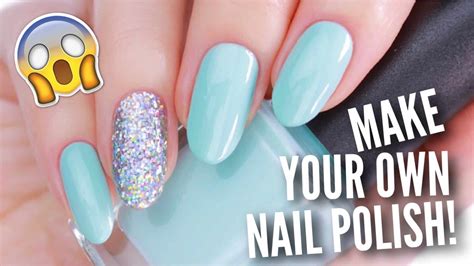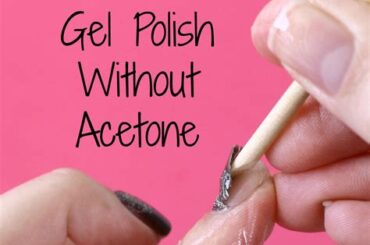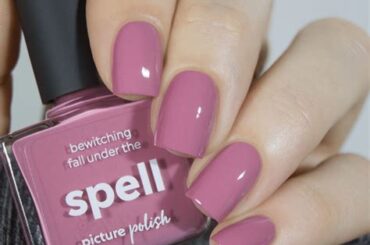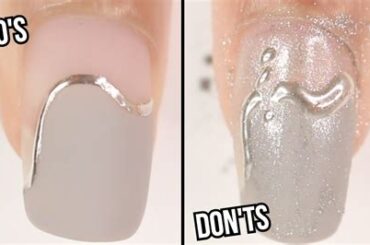Understanding the Basics of DIY Nail Polish
Are you tired of spending money on expensive nail polishes that chip or fade after a few days? If so, why not try making your own DIY nail polish? Not only is it a fun and creative project, but it also allows you to customize the colors and finishes to suit your personal style. In this blog post, we will explore the basics of DIY nail polish, including the essential ingredients and step-by-step guide to mixing your own unique shades. So, let’s dive in and unleash your inner nail artist!
Before we get started, let’s gather the essential ingredients for your custom nail polish. You will need a few key components: a clear base, pigment or colorants, mixing balls, and optional additives like glitters or shimmers. The clear base acts as the foundation for your polish and can be purchased at most beauty supply stores. Pigments or colorants are what give your polish its unique hue, and they come in a wide range of shades to choose from. Mixing balls are tiny stainless steel beads that help distribute the color evenly throughout the polish. Lastly, additives like glitters or shimmers can add a touch of sparkle or dimension to your creations.
Now that you have all the necessary ingredients, let’s explore different pigments and color combinations. When it comes to creating your own nail polish colors, the possibilities are endless. You can experiment with primary colors to mix and create secondary colors or play around with different shades to achieve unique tones. Don’t be afraid to get creative and mix colors you wouldn’t typically find in a store-bought polish. Remember, this is your chance to express your individuality and create shades that speak to you.
- Experimenting with Different Textures and Effects
Once you have mastered the art of mixing your own nail polish colors, it’s time to take your creations to the next level by experimenting with different textures and effects. Whether you prefer a glossy, matte, or metallic finish, there are various ways to achieve the look you desire. For a glossy finish, simply apply a layer of clear topcoat after applying your custom polish. If you’re into matte nails, try adding a matte topcoat or mixing a matte pigment into your base. For a touch of metallic shine, consider incorporating metallic pigments or flakes into your polish.
Storing and preserving your homemade nail polish is essential to extend its shelf life and maintain its quality. To ensure longevity, store your polishes in a cool, dark place away from direct sunlight, as exposure to light can cause pigments to fade. Additionally, make sure to tighten the caps properly to prevent air from entering the bottles, which can lead to evaporation. If you notice your polish thickening over time, simply add a few drops of nail polish thinner to restore its consistency.
So, there you have it – the basics of DIY nail polish. By understanding the essential ingredients, exploring different pigments and color combinations, and experimenting with various textures and effects, you can create your own custom nail polishes that are both unique and long-lasting. Happy crafting, and may your nails always be on point!
Gathering the Essential Ingredients for Your Custom Nail Polish
When it comes to creating your own custom nail polish, gathering the essential ingredients is the first step to achieving the perfect color and finish. The key to a successful DIY nail polish project lies in having high-quality ingredients that not only provide vibrant pigments but also ensure long-lasting wear. In this blog post, we will explore the must-have ingredients needed to make your very own unique and beautiful nail polish.
List of Essential Ingredients:
- Nail Polish Base: The base is the foundation of your nail polish and provides the desired consistency. Look for a clear base that is free from harmful chemicals and dries quickly.
- Pigments and Mica Powders: These are responsible for the color and shimmer of your nail polish. Choose pigments and mica powders that are cosmetic-grade and specifically formulated for use in nail polishes.
- Solvents: Solvents such as ethyl acetate or butyl acetate are essential for dissolving pigments and creating a smooth application. These solvents also help in drying the polish quickly.
- Thickeners: Thickeners like nitrocellulose or stearalkonium hectorite give the nail polish its desired viscosity and prevent it from becoming too runny.
- Plasticizers: Plasticizers like dibutyl phthalate or camphor help in making the nail polish more flexible and resistant to chipping.
- Opacifiers: Opacifiers such as titanium dioxide or zinc oxide are used to create opaque or pastel shades. They help in achieving maximum coverage in fewer coats.
Table of Ingredients:
| Ingredient | Function |
|---|---|
| Nail Polish Base | Foundation and consistency |
| Pigments and Mica Powders | Color and shimmer |
| Solvents | Dissolving pigments and quick drying |
| Thickeners | Viscosity control |
| Plasticizers | Flexibility and chip resistance |
| Opacifiers | Opacity and coverage |
Exploring Different Pigments and Color Combinations
When it comes to DIY nail polish, one of the most exciting parts is exploring different pigments and color combinations. This is where you can truly let your creativity shine and create unique shades that reflect your personal style. By understanding the basics of pigments and learning how to mix them effectively, you can unlock endless possibilities for creating your own custom nail polishes.
In order to gather the essential ingredients for your custom nail polish, you will need a few key components. The first is a clear nail polish base, which serves as the foundation for your creation. You can easily find this at your local beauty supply store or online. Next, you will need pigments or colorants to add the desired color to your polish. Pigments can be in the form of mica powders, liquid dyes, or even eyeshadows. Lastly, you will need small mixing bowls or containers, mixing sticks or brushes, and acetone or nail polish thinner for adjusting viscosity.
Once you have gathered all the necessary ingredients, it’s time to start exploring different pigments and color combinations. You can begin by experimenting with different types of pigments, such as metallics, neons, pastels, or glitters. Each pigment will have its own unique properties and effects, so it’s important to take note of how they interact with the base and other pigments.
- Start by adding small amounts of your chosen pigment to the clear nail polish base.
- Mix well using a mixing stick or brush until the pigment is fully incorporated.
- Apply a small amount of the mixed polish to a nail or swatch stick to see the color in action.
- Adjust the color intensity by adding more pigment for a bolder shade or diluting with clear polish for a more subtle hue.
- Once you have achieved your desired color, you can further customize the polish by adding additional pigments for a multi-dimensional effect.
As you explore different pigments and color combinations, don’t be afraid to experiment and mix several shades together. You might discover unexpected, yet stunning, color combinations that you would have never thought of before. Mixing complementary colors or playing with different finishes, such as matte and metallic, can also add a unique touch to your creations.
| Pigment | Color |
|---|---|
| Mica Powder | Wide range of shades, shimmer finish |
| Liquid Dye | Vibrant and intense colors, translucent finish |
| Eyeshadow | Various shades, matte or shimmery finish |
Storing and preserving your homemade nail polish is also crucial to maintain their quality over time. Make sure to store them in a cool and dark place, away from direct sunlight, as exposure to heat and light can cause the pigments to fade or separate. Additionally, adding a few stainless steel ball bearings to your nail polish bottles can help prevent them from settling and make mixing easier.
Exploring different pigments and color combinations is an exciting journey in DIY nail polish making. With a little creativity and experimentation, you can create your own unique shades that stand out from store-bought polishes. So, gather your ingredients, mix up some colors, and let your imagination run wild!
Mixing Your Own Nail Polish: Step-by-Step Guide
Creating your own custom nail polish can be a fun and creative way to express your personal style. Not only does it allow you to have complete control over the colors and finishes, but it also gives you the opportunity to experiment and create unique shades that you won’t find anywhere else. Whether you’re a nail art enthusiast or simply someone who loves DIY projects, this step-by-step guide will walk you through the process of mixing your own nail polish.
Gathering the Essential Ingredients
Before you begin mixing your own nail polish, it’s important to gather all the necessary ingredients. The basic components you’ll need include a clear nail polish base, pigments or mica powders for color, mixing balls, a dropper, and a small funnel. It’s important to choose high-quality ingredients to ensure the longevity and performance of your homemade nail polish.
Exploring Different Pigments and Color Combinations
When it comes to choosing pigments for your custom nail polish, the possibilities are virtually endless. You can opt for pre-made mica powders specifically formulated for nail polish, or experiment with different eyeshadow pigments for a wider range of hues. Consider mixing primary colors to create your own unique shades, or try blending different pigments to achieve stunning color combinations.
Mixing Your Own Nail Polish: The Step-by-Step Process
Now that you have all your ingredients ready, it’s time to start mixing your own nail polish. Here’s a step-by-step guide to help you through the process:
- Prepare your workspace: Find a well-ventilated area and cover your workspace with newspaper or a disposable tablecloth to protect it from any spills.
- Add the clear nail polish base: Using the small funnel, pour the clear nail polish base into an empty polish bottle, leaving some space to accommodate the pigments.
- Add the pigments: Depending on the intensity of the color you desire, use the dropper to add the desired amount of pigments into the polish bottle. Start with a small amount and gradually increase until you achieve the desired hue.
- Shake it up: Insert a mixing ball into the polish bottle and tightly close the cap. Shake the bottle vigorously for a few minutes to ensure that the pigments are thoroughly mixed.
- Test and adjust: Apply a small amount of the mixture on a nail wheel or nail tip to test the color and consistency. If needed, make any adjustments by adding more pigments or clear polish.
- Customize the finish: Depending on your preference, you can customize the finish of your nail polish by adding matte topcoat or metallic flakes for a unique effect.
By following these simple steps, you can create your own custom nail polish and unleash your creativity in the world of nail art. Mixing your own nail polish not only allows you to customize your manicures, but it also offers a rewarding and satisfying DIY experience. Get ready to show off your unique nail creations!
Experimenting with Different Textures and Effects
When it comes to nail polish, there is so much more you can do than just applying a simple coat of color. With a little creativity and experimentation, you can create unique nail looks that go beyond the ordinary. By incorporating different textures and effects into your nail polish creations, you can elevate your manicures to a whole new level. Whether you prefer a subtle shimmer or a bold metallic finish, there are countless options to explore. Let’s take a closer look at some of the exciting textures and effects you can experiment with to give your nails a touch of glamour.
Metallic: One of the most popular trends in nail polish is the metallic finish. Metallic nail polishes contain fine metallic particles that add a reflective shine to your nails. They come in a variety of shades, ranging from classic gold and silver to trendy rose gold and bronze. Whether you’re going for a futuristic look or want to add a bit of glamour to your nails, metallic polishes are a great choice. They can be worn alone for a sleek and stylish look or used as an accent color to create stunning nail art designs.
Glossy: The glossy finish is a classic choice that never goes out of style. It gives your nails a shiny and polished appearance, making them look healthy and vibrant. Whether you opt for a clear gloss or a colored one, this finish will instantly elevate your manicure. Glossy nail polishes are perfect for any occasion, from everyday wear to special events. They can be worn on their own for a simple and elegant look or used as a base for nail art to make your designs pop.
Matte: If you’re looking for a more understated and edgy look, the matte finish is the way to go. Matte nail polishes have a smooth and velvety appearance that adds a touch of sophistication to your nails. Unlike glossy polishes, they have a non-reflective finish, giving your manicure a unique and on-trend look. From muted neutrals to bold and vibrant shades, matte nails are a versatile choice that works well with any style or outfit. You can also combine matte and glossy finishes to create eye-catching nail art designs with contrasting textures.
| Texture/Effect | Description |
|---|---|
| Holographic | A mesmerizing effect that creates a rainbow spectrum on your nails. |
| Crackle | A unique texture that creates a cracked pattern as the polish dries. |
| Glitter | Adds sparkle and shine to your nails with small glitter particles. |
| Textured | Gives your nails a grainy or sandy finish for a tactile effect. |
Aside from the traditional glossy, matte, and metallic finishes, there are also other textures and effects you can experiment with. Some popular options include holographic, crackle, glitter, and textured nail polishes. Holographic polishes create a mesmerizing rainbow effect on your nails, giving them an otherworldly appearance. Crackle polishes produce a unique cracked pattern as they dry, adding an interesting texture to your manicure. Glitter polishes are perfect for adding sparkle and shine to your nails, as they contain small glitter particles. Textured polishes give your nails a grainy or sandy finish, providing a tactile effect that’s different from the smoothness of traditional nail polishes.
With all these different textures and effects available, the possibilities for creating stunning nail looks are endless. Whether you prefer a glossy, matte, metallic, or textured finish, there’s a nail polish out there that will tickle your fancy. So don’t be afraid to get creative and experiment with different combinations to find your signature style. After all, your nails are the perfect canvas to express your individuality and add a touch of glamour to your overall look.
Customizing the Finish: Glossy, Matte, or Metallic?
When it comes to customizing your own nail polish, there are endless possibilities to explore. One important aspect of creating your own unique nail polish is deciding on the finish. The finish of a nail polish refers to the effect it has on the nails once it dries. Will it be glossy, matte, or metallic? Each finish has its own unique appeal, and choosing the right finish can enhance the overall look of your manicure. Let’s take a closer look at each finish and how you can achieve it.
Glossy Finish: A glossy finish is the classic and most commonly used finish for nail polishes. It gives a shiny and polished appearance to the nails, creating a sleek and traditional look. To achieve a glossy finish, it is recommended to use a top coat specifically designed for this purpose. Apply the top coat over your custom nail polish once it has dried completely. The top coat will give your nails a smooth and reflective finish that adds depth and intensity to the color.
Matte Finish: If you’re looking to switch things up and create a more modern and edgy look, a matte finish is the way to go. A matte finish gives a flat, non-shiny appearance to the nails, creating a soft and velvety effect. To achieve a matte finish, you can either use a matte top coat or a matte nail polish. Apply the matte product over your custom nail polish, and allow it to dry completely. The result will be nails with a chic and sophisticated appearance.
Metallic Finish: For a glamorous and eye-catching look, a metallic finish is the perfect choice. A metallic finish adds a reflective and shimmery effect to the nails, making them appear bold and luxurious. To achieve a metallic finish, you can use a metallic nail polish or incorporate metallic pigments into your custom nail polish. Simply mix the metallic pigment into your base polish, ensuring it is well-blended. Apply the mixture to your nails and allow it to dry completely. The result will be nails that catch the light and create a stunning metallic effect.
Ultimately, the decision of which finish to choose for your custom nail polish depends on your personal style and preferences. You can even experiment with combining different finishes to create a unique look. Whether you opt for a glossy, matte, or metallic finish, customizing the finish of your nail polish allows you to express your creativity and showcase your individuality.
Tips for Storing and Preserving Your Homemade Nail Polish
As a DIY nail polish enthusiast, you have spent time and effort creating your own unique shades and finishes. Now that you have successfully mixed your nail polish, it is important to know how to properly store and preserve it to maintain its quality and longevity. Here are some useful tips to help you store and preserve your homemade nail polish.
1. Use airtight containers: When storing your homemade nail polish, it is crucial to use airtight containers to prevent air exposure. Oxygen can cause the polish to thicken or dry out, making it unusable. Consider using glass bottles with tight-fitting caps or metal tins with screw-on lids for optimal preservation.
2. Store in a cool and dark place: Proper storage conditions are essential for maintaining the quality of your nail polish. Excessive heat and sunlight can cause the pigments and ingredients to break down, resulting in color fading or texture changes. Store your homemade nail polish in a cool and dark place, such as a drawer or cabinet, to protect it from light and temperature fluctuations.
3. Keep away from children and pets: Nail polish contains chemicals that can be harmful if ingested or applied improperly. To ensure safety, store your homemade nail polish in a location that is out of reach for children and pets. Additionally, consider labeling your containers with a clear indication that the contents may be toxic.
4. Avoid shaking vigorously: While it may be tempting to vigorously shake your nail polish before use, this can introduce air bubbles and potentially disrupt the formula. Instead, gently roll the bottle between your palms to mix the ingredients without incorporating excess air.
5. Clean the bottle necks: Over time, nail polish residue can accumulate around the bottle necks, causing the caps to stick or the polish to dry out. To prevent this, clean the bottle necks thoroughly after each use by wiping them with a lint-free cloth or a cotton pad soaked in nail polish remover.
6. Store in a moisture-free environment: Moisture can cause nail polish to separate or become clumpy. Ensure that your storage area is dry and free from humidity to maintain the consistency of your homemade nail polish. Consider using silica gel packets or rice grains in the storage containers to absorb any potential moisture.
By following these tips, you can extend the shelf life of your homemade nail polish and continue enjoying your carefully crafted colors and finishes for a long time. Remember, proper storage and preservation techniques are key to maintaining the quality and usability of your DIY creations.
Frequently Asked Questions
Q: What are the essential ingredients for making DIY nail polish?
A: The essential ingredients for making DIY nail polish include a suspension base, pigments or colorants, mixing balls, and a nail polish bottle with a brush.
Q: How do I gather the essential ingredients for making custom nail polish?
A: You can easily gather the essential ingredients for making custom nail polish by purchasing them online from beauty supply stores or specialized DIY nail polish suppliers.
Q: Can I mix different pigments to create unique color combinations for my nail polish?
A: Yes, you can definitely mix different pigments to create unique color combinations for your nail polish. Experimenting with different pigments can help you achieve a wide range of custom colors.
Q: What is the step-by-step guide for mixing your own nail polish?
A: The step-by-step guide for mixing your own nail polish involves measuring and pouring the suspension base, adding the pigments or colorants, inserting mixing balls, and carefully mixing it all together before bottling the nail polish.
Q: How can I experiment with different textures and effects in my homemade nail polish?
A: You can experiment with different textures and effects in your homemade nail polish by adding special effects pigments, glitters, or nail art powders. These additives can create unique looks such as holographic, jelly, or glittery finishes.
Q: What options do I have for customizing the finish of my homemade nail polish?
A: You have the option to customize the finish of your homemade nail polish by choosing between a glossy, matte, or metallic finish. This can be achieved by adding specific polish bases or topcoats.
Q: How can I store and preserve my homemade nail polish?
A: To store and preserve your homemade nail polish, it is recommended to keep it in a cool, dark place away from direct sunlight or extreme temperatures. Additionally, make sure to seal the nail polish bottle tightly to prevent air and moisture from entering.





